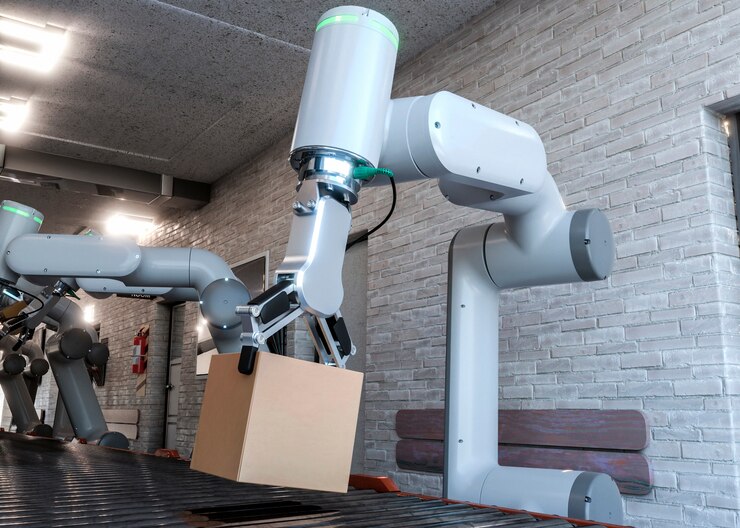There is a revolution taking place in the retail space, and it isn’t a new product that looks fancy or a marketing campaign that makes waves. It’s artificial intelligence (AI), and it’s affecting every industry, from small local businesses to multinational conglomerates.
AI is Changing Retail: From Personalized Shopping to Smart Supply Chains
Imagine entering a store where, like magic, product recommendations emerge on screens, virtual assistants answer your inquiries with astonishing precision, and the lights change to suit your mood. This is not just a sci-fi dream; this is the AI-powered retail of the future. The following are some significant ways AI is changing the sector:

Customized Shopping:
To better understand consumer preferences and purchasing patterns, AI systems are evaluating customer data. This enables merchants to provide personalized recommendations, discounts, and even layout changes of stores to meet the needs of certain customers. In a perfect world, when you enter a store, a carefully chosen assortment of products that you are likely to adore are displayed to you based on your previous purchases and browsing activity.
Improved Customer Experience:
The days of having to wait in line for assistance are long gone. Chatbots and virtual assistants driven by AI are on hand around the clock to respond to inquiries, handle problems, and even provide product demos. This increases client satisfaction while freeing up human workers to work on more difficult jobs.
Dynamic Price and Inventory Management:
AI is assisting merchants in maximizing price plans that take into account current market conditions and demand. That means there won’t be any more overpaying or missing out on sales. AI systems can also predict demand with startling precision, which enables merchants to manage inventory more effectively and lower stockouts.
Streamlined Operations and Logistics:
AI is automating many elements of retail operations, from delivery trucks that drive themselves to robots that take over warehousing chores. This increases productivity while lowering labor expenses and freeing up human resources for more strategic responsibilities.
Security and Fraud Detection:
AI is continuously learning and developing, which makes it skilled at spotting fraudulent behavior in real-time. This guarantees a safer purchasing environment for all and shields shops and customers from monetary damages.
AI’s Effect on Retail: The Data Speaks for Itself
The advantages of AI in retail are empirically proved and go beyond theory. Research has demonstrated that AI can result in notable advancements in:
– Operational efficiency: AI has the potential to increase retail earnings by up to 30% by 2030, according to sources.
– Customer satisfaction: According to a survey, 80% of consumers are more willing to conduct business with a firm that employs artificial intelligence (AI) to customize their experience.
– Revenue growth: According to research, by 2025, artificial intelligence could boost the global retail economy by up to $1 trillion.
Problems and Issues: The Other Side of the Coin
Although artificial intelligence (AI) has enormous potential for the retail sector, it’s critical to recognize the difficulties and worries associated with its adoption:
– Job displacement: Retail jobs may be in jeopardy as AI automates more tasks. This calls for funding retraining initiatives and making sure displaced workers have a seamless transition.

– Discrimination and bias: AI systems are susceptible to bias, which may result in the unfair treatment of some clients. Ensuring that AI systems are developed and utilized responsibly, prioritizing equity and inclusivity, is imperative.
– Privacy issues: Data security and privacy are issues when using AI to use client data. Retailers must employ strong security measures to safeguard consumer data and be open and honest about how they gather and utilize it.
AI in Retail: The Upcoming Field
Prominent merchants have been observing and interacting with the rise of artificial intelligence (AI) in the retail space, which has shaped consumer purchasing behavior and retail operations. Precedence Research’s analysis projects that the global AI retail market will develop at a compound annual growth rate of 18.45% from 2023 to 2032, with a projected value of USD 45.74 billion.
In the retail industry, what does artificial intelligence mean?
Artificial Intelligence (AI) in the retail industry refers to a variety of technologies that simulate human intelligence and behavior, including robotics, computer vision, natural language processing, and AI-driven analytics. Also, creating algorithms that continuously learn from data and get better over time is called machine learning, a branch of artificial intelligence.
How Artificial Intelligence is Applied in Retail
AI-driven analytics and machine learning are combined in the retail industry to:
– Examine vast volumes of data – Spot trends – Form hypotheses
These technologies are revolutionizing the retail industry in three key areas: enhancing the customer experience, raising sales, and cutting expenses. They also allow for more timely and accurate information to be included in corporate decisions.
Retail AI Use Cases and Examples
1. Demand forecasting: For retailers, forecasting demand is essential since it informs inventory planning processes. Predictive analytics is used by top retailers like Simons to improve selection and prediction accuracy.

2. Personalized shopping: Product recommendations are mostly based on user preferences by AI-driven analytics analyzing customer data. For example, Amazon uses both history and current data to personalize each customer’s homepage.
3. Supply chain optimization: AI streamlines the system, cutting down on mistakes and raising productivity. To prevent overproduction, Zara modifies their production schedules in response to demand estimates produced by AI.
4. Inventory management: Real-time inventory monitoring is easier for shops like Lowes by AI-powered technologies like sensors and camera vision. This increases the effectiveness of restocking.
5. client service: Sephora’s AI-powered chatbots offer round-the-clock assistance, increasing client interaction.
The Retail Industry’s AI Future
The retail industry will continue to grow and innovate as a result of the partnership between technology businesses and retailers. What lies ahead is:
– Increased operations-focused and client-facing AI programs
– The continuous advancement of machine learning – The growing digitization of supply chains
In the digital age, AI is unquestionably changing retail, affecting hardware, software, and services. Retailers who adopt AI put themselves in a position to gain substantial advantages in a changing industry.




